An amplifier is an electronic device that increases the amplitude of a signal. For example, when you play a sound into a microphone, it produces a small voltage corresponding to the sound played. You can then send this signal to a speaker, which turns it back into a sound. If we want the sound from the speaker to be louder than the sound originally sent into the microphone, we need to increase the amplitude of the signal.

Working of an amplifier
This is just one application of an amplifier. It is one of the most important and widely used devices in electronics. In a previous article, I showed how you can make a common-emitter amplifier using a bipolar junction transistor. That involved making a circuit with multiple resistors and capacitors and paying close attention to the voltages and currents involved, which can be a bit cumbersome. In this article, we’ll be looking at using operational amplifiers (OpAmps) instead.
An OpAmp is an integrated circuit that includes almost all of the necessary components to make an amplifier. With the addition of just a few resistors and a DC power source, we can easily make a couple of different kinds of amplifiers. Let’s take a look at how an OpAmp works and how we can work with them.
The circuit symbol for an OpAmp looks like this:
Amplifier symbol
You can see there are two input terminals and one output terminal. In addition, the OpAmp has two more terminals for the positive and negative power rails, which are connected to a DC voltage source. These are typically not shown on circuit diagrams as it is implied that the OpAmp needs to be powered to be useful.
For this article, we will be viewing the OpAmp as a black box, meaning we do not care about its internal workings, only how we use it. There is plenty of information about the internal workings out there, and it is all very interesting, but that is outside our scope here.
There are two important “golden rules” you need to know to understand how we analyze an OpAmp circuit.
Golden Rule #1: The voltage between the inputs is zero.
This means that the two input terminals, V+ and V-, are at the same voltage. This is very useful and simplifies a lot of calculations.
Golden Rule #2: No current flows into the input terminals.
Likewise, this simplifies calculations. Let’s look at a circuit and see how these rules help us.

Our input is a sine wave with an amplitude of 0.5 V. We want to analyze this circuit and find the amplitude of the voltage at the output.
V+ is connected to the ground, so it is at 0 V. Therefore, per golden rule #1, V- must also be at 0 V. Therefore, the voltage across the 1 kΩ resistor is 0.5 V - 0 V = 0.5 V. Ohm’s law tells us that the current through this resistor must then be 0.5 V / 1 kΩ = 0.5 mA. Golden rule #2 tells us that no current goes into the input V-, so we know that the same current flows through the 10 kΩ resistor.
The voltage drop across the 10 kΩ resistor is therefore 0.5 mA x 10kΩ = 5 V. Since V- is 0 V, this means the output is -5 V!
This is an interesting result. The amplitude is 10 times larger at the output than it was at the input, but the negative sign means the sine wave was inverted, meaning the high points become low points, and vice versa. Here is a plot of the input and output, respectively.

Result of an Inverting Amplifier
We call this value the gain, and it is found by dividing the output by the input.
Gain = Vout/Vin=-5 V/0.5 V= -10
Why -10? It turns out that the gain from this circuit will always be negative, and the magnitude is the ratio of the two resistors! If we replace our resistors and output with variables, our circuit looks like this:

Doing the same analysis, we find that the gain comes out to:
Gain = -R2/R1
This means we can control the gain with our choice of resistors. This famous circuit is called the inverting amplifier. Note that the amount you can amplify is limited by the supply voltage. For example, if your positive supply is 15 V, that is the highest amplitude you can achieve. If you choose your gain such that your output would be larger than this, your output waveform will be distorted.
Let’s look at one more OpAmp circuit.

Once again, using the golden rules and some simple circuit analysis, you can find out the gain by finding the ratio between the output and input.
Gain = Vout/Vin=1+ R2/R1
Once again, the ratio between the resistor values controls the gain. Notice that the gain is positive this time, meaning the output is not inverted. Thus, this circuit is fittingly called the non-inverting amplifier. If we used our earlier values of 1 kΩ and 10 kΩ, this circuit would give us a gain of 11, which would amplify a 0.5 V input to 5.5 V.
There is a lot more to operational amplifiers, including a wide range of characteristics, performance parameters, and many, many more configurations, all with their own applications. That said, I hope this article has given a good overview of how you can get started using OpAmps to make simple amplifier circuits.
































